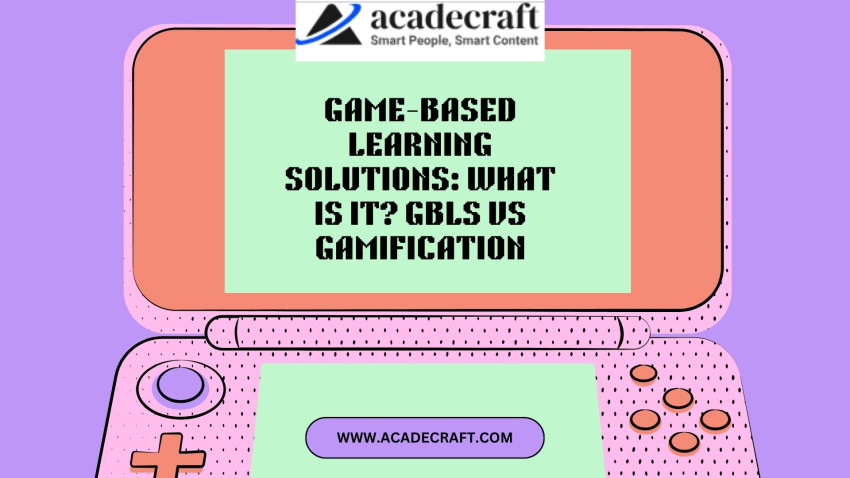
The learning needs of modern students are rising with a straight rise in the changing digital landscape. Hence, learning and training institutes are focusing on the use of innovative learning solutions. The use of game-based learning solutions and gamification are two of the newest approaches.
Do you know that both game-based and gamification may look the same but are different from each other? So today, let us help you understand the game-based learning solutions and gamification in detail. We’ll help you go through the key differences between the two based on different pointers.
What are game-based learning solutions?
These solutions refer to the different educational tools and approaches using the interactive elements, simulations, and games for primary mode of learning and teaching. These solutions focus on unlocking the understanding, skills, and knowledge of the different learning concepts.
The key components of game-based learning solutions are:
Aligning to educational goals
It focuses on the achievement of learning goals along with the overall educational goals of the organization.
Creating an interactive gameplay
It is easy to create an interactive gameplay using the dynamic and other elements in the learning methods.
Helps in creating an immersive learning environment
Game-based learning helps in creating an overall immersive learning environment for the students. Hence, it benefits the organizations also.
Immediate feedback
It is easy to use the game-based learning methods for including the immediate feedback in the learning programs. Hence, the trainers can incorporate these feedbacks for overall content improvements.
Incorporating storylines
The use of the dedicated storylines help in creating end-to-end narratives in the game-based learning solutions.
What is gamification?
It is the dedicated process of integrating different game-like elements, design, and mechanics into the learning program. Hence, the commonly found gaming elements are quickly added in the learning programs.
The key components of gamification covers:
Points
Learners earn different points based on their performance.
Achievements
The virtual symbol of achievement like badges are used for completing specific tasks in the learning program.
Levels
It is easy for the learners to progress through the different levels using the gamification methods.
Leaderboards
These boards display the performance of the users based on the different rankings in the learning program.
What are the key differences between game-based learning solutions and gamification?
After having a quick understanding of game-based learning solutions and gamification, it is easy to understand their key differences.
Both are the modern approaches to training or learning programs, however, these differ in implementation and approach. We’ll try to differentiate between game-based learning solutions and gamification based on definition, format, aim, design, complexity, and feedback.
Definition
The game-based learning refers to the use of real games, interactive activities, and simulations for different educational programs. These consist of standalone games offering to learn specific topics or skills.
Gamification refers to the seamless integration of the different game elements like leaderboards, points, and badges into the non-game context. It focuses on increasing the motivation and learner engagement.
Format
The format of game-based learning is to create games or simulations with fully-developed objectives, rules, and narratives. It covers complex simulations or simple quiz games.
The format of gamification covers the addition of game-like elements in the non-gaming context. It covers the challenges, rewards, or point systems in the learning programs.
Aim
The game-based e-learning solutions aim to make students learn different skills and objectives using gameplay only. The different learning outcomes are integrated into game mechanics.
The format of gamification covers application of the game elements into a non-gaming context for increased learner participation, motivation, and engagement. Hence, the gamification aims to enhance the learner experience over the learning abilities.
Design
The design of game-based learning covers complete development of a game including different game mechanics, characters, and storylines. The instructional design principles are seamlessly integrated with the gameplay.
The design of gamification covers the integration of game mechanics into an existing learning program. Hence, the key design consideration here is to focus on the incorporation of gaming elements without overlapping the main learning content.
Complexity
The complexity levels of the game-based learning solutions differ based on the use of simple games or complex games. Hence, the complexity level is determined by the depth of the learning content and the key educational objectives.
The complexity of gamification is less due to the addition of simple game elements and mechanics. This is because the emphasis of the gamification is to enhance the learner's motivation rather than offering an immersive gaming experience.
Feedback
The game-based learning feedback is immediately embedded in the gameplay. Hence, it offers real-time performance details and progress to the learners.
The gamification feedback is offered in the form of rewards, points, and badges. This feedback is not directly tied to the different learning steps like in game-based learning.
Key thoughts
Game-based education is an innovative method of increasing the overall learner engagement and learning effectiveness of the different learning solutions. Many businesses are preferring to go for game-like elements in their learning programs.
It is easy to understand the key differences between gamification and game-based learning for enhanced usability.





